It's short-sighted to think of an artist confined to a single medium. Yes, in most cases, a creator shines in one area. But it is interesting to view — or hear — an artist apply the traits of one medium to another.
The term "artist" is typically reserved for those who work in the visual or tangible realm. That's not to say musicians aren't artists, or that they're confined to just music. Many are not, and it can be fascinating to enjoy art from their musical perspective or the other way around. Often the musician was an artist first, or creates artworks as an artistic release — think Kim Gordon or Miles Davis.
We talked to five Rochester musician-artists and had them dissect the origins of their creative expressions. Which came first? Which is paramount? If forced to choose, which direction would they go? Read on for their answers.
Darren Brennessel
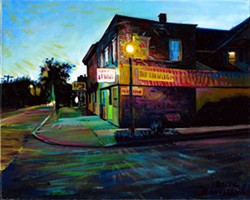
- PHOTO PROVIDED
- A painting by Darren Brennessel of the corner of Winton Road and Heather Street.
Whether he's acting as the mutton-chopped mastermind behind the garage-ified, one-man-studio outfit McFadden's Parachute, or as one of the two sunshine supermen behind The LSD Enigma, Rochester rocker Darren Brennessel just oozes rock 'n' roll cool. And the dude paints, too.
He received his sheepskin in graphic design and illustration from RIT in 1994 and another degree in fine-arts painting in 1999. According to the 49-year-old Brennessel, the artist came long before the musician — 24 years before, to be exact.
"I first started drawing — according to my mom — when I was 2 years old," Brennessel says. "I was cognizant of being very excited about drawing and art. I started out doing nature scenes; barns, trees, animals. Then the Golden Books and Dr. Seuss, I was drawing things out of them. I was very fascinated with illustration by watching Captain Kangaroo. But I fell in love with art beyond illustration and cartoons by age 4."
And there was rock 'n' roll, too. "Music was there right at the same time as I became aware of being in love with art. I was a fan of 1960's pop/rock — [songs like] 'Yummy Yummy Yummy' by the Ohio Express and 'Windy' by The Association. I heard them in the car as my mom was driving through the streets of Dansville and it blew my mind. I was hooked and I've always gravitated to and been fascinated by the look of those guys, their instruments, their ability to play. I always wanted to do it, too."
There was just one problem: "I was completely terrified of performing," Brennessel says. "I was extremely shy. I didn't like doing anything in front of people. And I knew to play music I would have to do that. That was a big deterrent in picking up an instrument until I was 24."
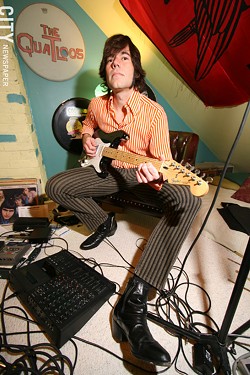
- PHOTO BY FRANK DE BLASE
- Darren Brennessel is the one-man show behind McFadden's Parachute, and also plays in The LSD Enigma.
He taught himself how to play the drums and sought professional help. "The thing is, I always had the look," he says. "I said, 'I can't have this look and not do this.' So I went to a hypnotist to get over my stage fright."
As for his visual art, Brennessel paints dreamy cityscapes. Though urban and man-made, the artist conveys the personality of Rochester's various cityscapes over and above the personality and life hustling around these streets buildings, bridges, and skylines. His job as a surveyor affords him the repeated walkabouts and look-sees.
"I can walk out the door and see a painting in something that seems bland to other people," he says. His paintings "incorporate movement, color, emotional response. What I try to do is take my feeling, what I felt when I saw that scene — what basically blew my mind with color, perspective, architecture, geometry, lighting — and urge the viewer to feel the same thing I felt in that moment, in that atmosphere."
And here's where it crosses over. "I see things in my head," Brennessel says. "And I have to visually see music to hear it, whether it's playing the lyrics out like a scene in a movie in my head... Even when I see music structure, it's all in odd shapes and mathematics. So a painting described musically, to me, has all the elements of listening to a song. You've got visual, you've got movement. The only thing missing is sound. I'm a visual thinker, I see music as images."
The two aspects pull at Brennessel relentlessly.
"It kind of tears me apart," he says. "Because I've always felt if I could focus on one or the other, I would excel at one or the other. The two are tied together. Artists like Norman Rockwell just painted, but I can't do that. I was born to do both. I wouldn't want to have to choose.
Amanda Ashley
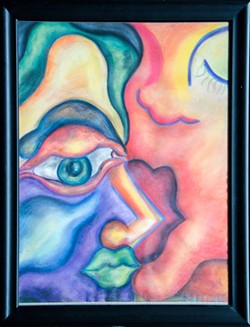
- PHOTO PROVIDED
- A painting by Amanda Ashley.
Of all the musician-artists presented in this piece, Amanda Ashley's bio reads like more of a see-saw than the merry-go-round the other artists ride. Her level of dedication to both her song-centric pop music and her large, carnival-esque paintings has forced her hand. She's had to decide between one or the other from time to time.
"Initially, I went to school for music education," Ashley says. "But I ended up switching because I was a little bored with the music program. It was very classically oriented. It was by the book, note for note. And I had just never been like that in my life. I was struggling with music theory. It just felt like it was draining me. There's structure for both, but with art I felt I had a little more liberty to do what I wanted to do. My whole life I'd done art. I wanted to do a major, but the time that was involved in both majors made it impossible."
So Ashley switched to art. Her dad lit the visual art fire years before. "My dad drew," she says. "He did a lot of pen-and-ink work. He's retired now but still does wood sculpting. Growing up I would draw with him. I had coloring books and I wouldn't color, but rather try to draw what I would see. I loved dinosaurs."
Art predominated throughout Ashley's middle- and high-school careers. "My art teachers would enter me in contests," she says. "But music and art always went hand in hand. I had given up my lunch period in high school so I could take both music and art classes."
While attending SUNY Fredonia and working as a teaching assistant, Ashley exhibited work and cranked out two paintings a week, all the while playing music off campus. She graduated with a BFA and came to Rochester to continue at RIT in hopes of getting her master's degree.

- PHOTO BY FRANK DE BLASE
- Amanda Ashley is a singer-songwriter who performs all over the Rochester area.
"I thought I'd come out a college-level professor. But I wasn't happy. I didn't know what I was going to do," Ashley says. "I realized I wasn't happy because I wasn't doing music. I wasn't writing music at all. So I started writing again and I booked my first show at Starry Nites Café. I got such a rush from performing again. So I started booking more, eventually fell into my first band, and it took off from there."
The move from art to music proved a little more gratifying financially, getting paid nightly as opposed to waiting for a painting to sell. "Music is little bit more instantly lucrative than in the art world," says Ashley.
In her own opinion, the two art forms aren't really the same. "The way I paint is kind of loud," she says. "I base my songs on how I feel. When I approach a canvas, I go off from the mood. Still, all aspects of my creativity are a little segregated. All the different aspects speak to a different side of me."
Doug Mac
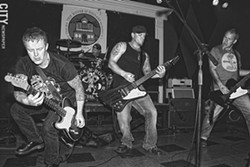
- PHOTO BY FRANK DE BLASE
- In addition to his prolific illustration work, Doug Mac (pictured, far right) is the bassist for local band Rock 'n' Roll Social Club.
Doug Mac can thank — or blame — his old man for sending him down the road to lowbrow art littered with camp horror and hard rock. Mac divides his time between slinging bass for heavy rockers Rock 'n' Roll Social Club, and slinging ink that brings to life characters that are drawn mondo bizarro and over the top. He has illustrated covers for The Village Voice, designed and drawn the posters for the upcoming custom-van documentary "Vannin'" and the Monsters of Rock Tour, created roughly 40 to 50 CD covers, and produced artwork for anyone who digs hot rods, zombies, mayhem, explosions, and boobs the size of Volkswagens.
Both artistic practices celebrate extremes for the 48-year-old artist-musician, who was first exposed to both disciplines at a tender age. "I grew up on horror movies and Mad Magazine," Mac says. "I saw 'Creature From The Black Lagoon' when I was 5. That sold me right there. My dad and I used to stay up late on Friday nights and watch 'Frightening Flickers.' About that time my dad brought home my first Mad Magazine."
The work of cartoonists Basil Wolverton and Wally Wood made a big impression on little Mac. "I was blown away by the stuff they were doing — crime-drama stuff and horror-movie stuff all kind of intertwined. It was really amazing," Mac says. At the same time he was going gaga for the graphics, the rock 'n' roll undertow started creeping in, and by age 10 he was doing both — though there was a bit of a tug-o-war.
"I took private art lessons when I was a kid," he says. "But I rebelled against it because I wanted to play music. I didn't want to be an artist. I wanted to be a musician." Now it's a little clearer to Mac just who and what he is.

- PHOTO PROVIDED
- An illustration by Doug Mac.
"I'm a rock 'n' roller who makes art," he says. "I started drawing and playing music when I was 10 years old. I got my first band together when I was 14 and did my first flyer for the first show we had at the rec hall at Webster Schroeder High School. I made a flyer and put it all over school. It was of a guy with a lightning bolt going through him. I loved drawing band logos — Saxon, Judas Priest."
Mac made the move to Los Angeles when he was 22, playing with the band Mr. Maccob for about eight years. While he found the scene crowded with musicians, artists weren't nearly as plentiful. That provided an opportunity.
"All my friends were in bands," says Mac. "And I'd make flyers for them. You'd go up and down the Sunset Strip and hand out flyers. They'd see my flyers for my band and say, 'Hey man, make a flyer for my band, I'll give you 25 bucks.' That's how it started."
Understanding the music's origin and purpose is key in Mac's art. "When I work for a band, I listen to their music and get a feel for it," he says. "When I do a metal band's logo I think more pointy. I enjoy working with rockabilly bands; there's a lot of cool tattoo imagery I can use in it. With hard rock I put a little fun and a little bit of darkness to it."
And though he does both music and art, the choice is clear for Mac — if it ever came down to making one.
"Art," he says. "There are no personalities. I can work alone. I work with management companies and artists and they give me a little input, but 90 percent of the people I work with come to me because they like my work and know I'll do a good job for them."
A Doug Mac original takes the artist between 25 and 40 hours start to finish. And he's in high demand, churning out roughly three pieces a month that will go in a hot-rod magazine, a t-shirt for a sport team or bar, or a band show poster between his own loud sojourns on stage.
"I've found a way to make money with art...barely," he says with a laugh. "The main thing is I've got to like it. At the end of the day, if I get a smile out of it, I've done my job right."
El Destructo
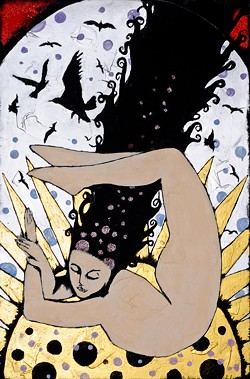
- PHOTO PROVIDED
- A painting by El Destructo.
El Destructo's music and art are studies in a dark, eviscerated, hip humanity. He ponders the approach he takes with both and sums it up thusly: "Having a crude style and trying to take the edges off so it doesn't sound so crude," he says. "It's taken me 20 years to do that with painting, it probably took me 15 years with music. I don't want it to be abrasive or harsh." But there still is a simplicity that may give a few people rug burns.
"It's naturally in me," Destructo says of the bluntness of his art. "But I would rather comfort you. Those little edges that still poke out give it reality. I try to project a better self than I am. All these artists and poets are like, 'Oh, I'm miserable, I'm miserable.' OK, the world's miserable and you just reinforced it. Thank you."
Other than art classes in school and the urging of his mother starting when he was 10 years old, Destructo — now 44 — is a self-taught painter who learned guitar the same way. His paintings aren't crude, but certainly aren't overdone or blended to the point of eliminating the artist's hand. You can still see and feel the tone and the brush strokes.
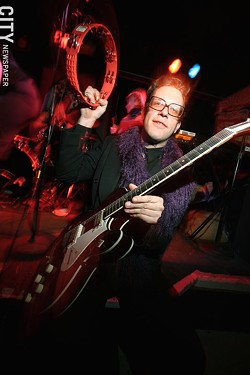
- PHOTO BY FRANK DE BLASE
- El Destructo performs music as both a solo artist and as part of a band.
"It's surreal," says Destructo. "I try to give it an incandescent light. It's something beautiful and dark and mysterious."
The same goes with his music; rock 'n' roll with a rough-hewn raggedness and splendor played solo or with a backing band. It's assumed by some to be perfect as is, without much practice. Destructo chuckles in response.
"You would think that," he says. "But to get those two chords, it does [require work]."
Though the two disciplines demand their own space, Destructo often works them out in the same session. He has to. "What else am I going to do? It's a real stress release," he says. "I'll be painting at like 7 at night and I look at the clock and it's 2 a.m. And it's like, 'Where did those hours go?' They just melted away, it was peaceful, listening to music. I played my guitar a little while the paint was drying... It's like therapy."
Whereas a live music gig can net a less than awesome payday, Destructo frequently shows his art around town, and it almost always sells out.
"I'm making $200 on a painting and $40 playing a show and I've got to split it with the band, besides the stress, and worry if they're gonna show up," he says. "But I play music every day. Every day I pick up my guitar, play a G and D chord and go, 'Wow, that sounds nice."'
Thievin' Stephen
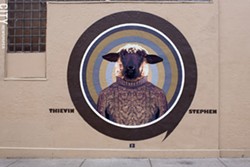
- FILE PHOTO
- Thievin' Stephen's 2013 entry into the Wall/Therapy mural project can be found on the side of the Tap & Mallet on Gregory Street.
Both of Thievin' Stephen' s mediums are borrowed, manipulated, and re-purposed by this street-artist-slash-musician. Whether it's through his extensive and epic work on public walls brought to life by the Wall/Therapy mural project, or through beats culled from his endless library-o-rhythm with artists like Homeboy Sandman, Thievin' Stephen's output is immense and undeniable. Art and music are neck and neck in importance to this 30-year-old, but art came first — chronologically, at least.
"I got into making beats in 2001," Stephen says. "I think I started playing them for people in 2007." He started into his visual output in the late 1990's. "More as an excuse to put on headphones and zone out," he says. "I really wasn't showing my artwork to anyone. I think I started showing beats first."
"I started cutting stencils in 1997," he says. "I didn't think it was anything I was going to stick with. I was just trying to put band logos on my shit and I liked spray paint. I was pretty young, I didn't know it was a 'thing.' I didn't know stencil graffiti existed. I thought, 'I could do that; cut out the letters and spray paint the words.' It was just logos and other people's artwork, really."
The common thread between what is heard and what is seen is Thievin' Stephen's underground aesthetic. Some of his favorite bands fell under that category, as well as a shared commonality with his visual, sometimes guerilla art. He doesn't want to choose between the two.
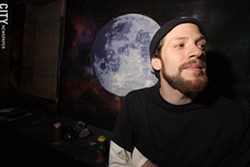
- PHOTO BY FRANK DE BLAS
- Thievin' Stephen is a DJ who creates beats by sampling and layering multiple sounds — not unlike his visual-art stencil style.
"To me it's all the same thing," he says. "It's an outlet. It's a way to express myself. I really apply the same approach to both. I start with source material — a sample or a photo that inspires me — chop the living hell out of it, reconstitute it, and layer it upon a million other layers."
He made a brief shift to a primarily art side after a catastrophic hard-drive crash in 2010. "I lost tons of recorded files and beats I had made," he says. "I started doing art more to kind of fill that void, fully intending to return to music. During that time I made some leaps, figured some stuff out with my technique, and applied what I had been doing with music to art. It brought my art to a new level."
"In terms of the work, I think they benefit from each other," he says. "I think in terms of the career it's a total hindrance. Progress in one field doesn't translate to progress in the other. In terms of beat making, I'm a huge gravedigger.... That's my look at immortality; to dig through and find some old record that nobody cared about and give it another life. Even sampling — some people call it theft, but to me it's a resurrection."
In some cases people familiar with Thievin' Stephen's beats are oblivious to his art, and vice versa. "Sometimes I'm really surprised the people don't know I do the other," he says. "And there's a whole 'nother half they can check out if they want to."
